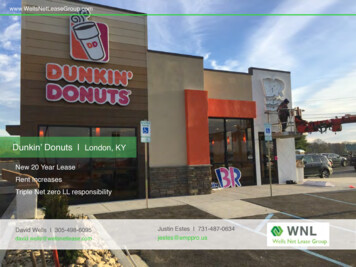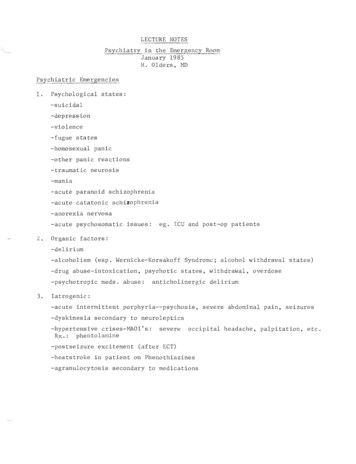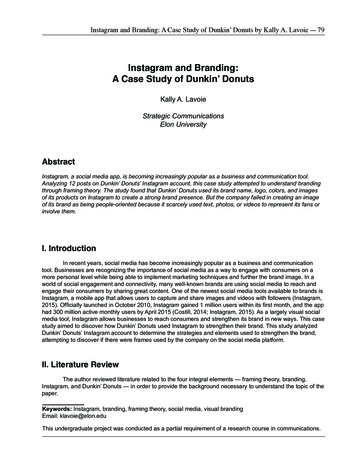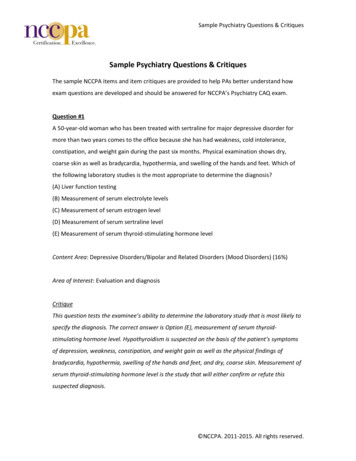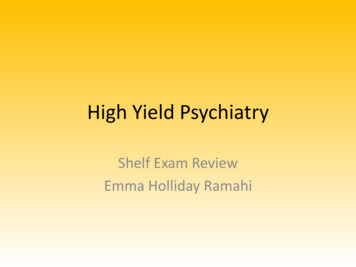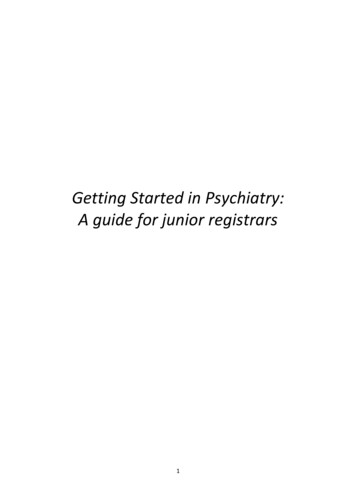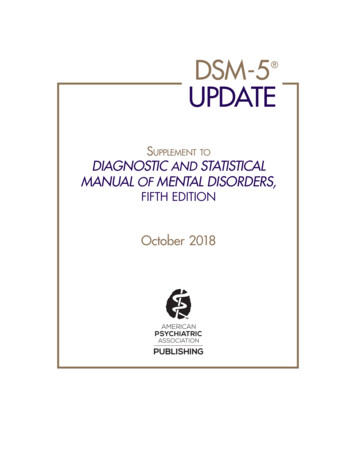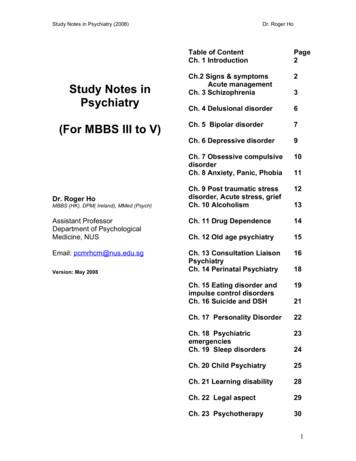
Transcription
Study Notes in Psychiatry (2008)Dr. Roger HoTable of ContentCh. 1 IntroductionPage2Ch.2 Signs & symptomsAcute managementCh. 3 Schizophrenia2Ch. 4 Delusional disorder6Ch. 5 Bipolar disorder7Ch. 6 Depressive disorder9Ch. 7 Obsessive compulsivedisorderCh. 8 Anxiety, Panic, Phobia10Ch. 9 Post traumatic stressdisorder, Acute stress, griefCh. 10 Alcoholism12Assistant ProfessorDepartment of PsychologicalMedicine, NUSCh. 11 Drug Dependence14Ch. 12 Old age psychiatry15Email: pcmrhcm@nus.edu.sgCh. 13 Consultation LiaisonPsychiatryCh. 14 Perinatal Psychiatry16Ch. 15 Eating disorder andimpulse control disordersCh. 16 Suicide and DSH19Ch. 17 Personality Disorder22Ch. 18 PsychiatricemergenciesCh. 19 Sleep disorders23Ch. 20 Child Psychiatry25Ch. 21 Learning disability28Ch. 22 Legal aspect29Ch. 23 Psychotherapy30Study Notes inPsychiatry(For MBBS III to V)Dr. Roger HoMBBS (HK), DPM( Ireland), MMed (Psych)Version: May 2008311131821241
Study Notes in Psychiatry (2008)Chapter 1IntroductionThe purpose of writing this set of notes is toprovide a concise summary of psychiatry and tohelp medical students to have rapid review forexamination.Ch. 2 Definitions of signs and symptomsThe MCQ exam often confuses you with thefollowing terms (Levi, 1998):EcholaliaRepetition by thepatient of theinterviewer’s wordsor phrasesStereotypyRegular, repetitivenon goal-directedmovement(purposeless)Waxy flexibilityPatient’s limb can beplaced in anawkward postureand remain fixed inposition for long timedespite asking torelax; occurs inSchizophrenia (SZ)CatalepsyMotor symptom ofschizophrenia, sameas waxy flexibilityAutomaticobediencePatient doeswhatever theinterviewer asks ofhim irrespective ofthe consequencesMitgehenAn extreme form ofmitmachen in whichpatient will move inany direction withvery slight pressureAmbitendenceThe patient beings tomake a movementbut beforeEchopraxiaImitation by thepatient of theinterviewer’smovements.MannerismAbnormal, repetitivegoal-directedmovement (of somefunctionalsignificance)MitmachenPatient’s body canbe placed in anyposture; whenrelaxed, patientreturns to restingpositionCataplexySymptom ofnarcolepsy in whichthere is sudden lossof muscle toneleading to collapse,occurs in emotionalstate.Gegenhalten(opposition)The patient willoppose attempts atpassive movementwith a force equal tothat being applied.NegativismExtreme form ofgegenhalten,motivelessresistance tosuggestion/ attemptsat movement.PreservationThe senselessrepetition of apreviously requestedDr. Roger Hocompleting it, startsthe oppositemovementNeologismsThe patient useswords or phrasesinvented by himselfObsessionsRecurrent, persistentthoughts, impulses,images that thepatient regards asabsurd and alienwhile recognising asthe product of hisown mind. Attemptsare made to resistor ignore themVerbigeration(word salad)Disruption of boththe connectionbetween topics andfiner grammaticalstructure of speechOccurs in SZLoosening ofassociationsLoss of the normalstructure ofthinking. Muddledand illogicalconservation thatcannot be clarifiedOccurs in SZDepersonalisationA change in selfawareness such thatperson feels unrealBipolar IManiaAffectEmotional state at amomentEuphoriaSustained andunwarrantedcheerfulnessmovement, evenafter the stimulus iswithdrawnMetonymsUse of ordinarywords in unusualwaysDelusionsA false belief withthe followingcharacteristics firmlyheld despiteevidence to thecontrary; out ofkeeping with theperson’s education &cultural background,content often bizarreVorbeireden(talking past point)The patient seemsalways about to getnear to the matter inhand but neverquite reaches it.Occurs in SZFlight of ideasPatient’s thoughtsand conservationsmove quickly fromone topic to another,the links betweenthese rapidlychanging topics areunderstandableAssociated withrhyming, punning &clang associations.DerealisationA change in selfawareness such thatthe environmentfeels unrealBipolar IIHypomaniaMoodEmotional state overa longer periodEuthymiaA normal mood stateNeither depressed ormania2
Study Notes in Psychiatry (2008)Chapter 3Schizophrenia3.1 Types of schizophrenia- Paranoid schizophrenia: prominent well –systematised persecutory delusions orhallucinations. More common withincreasing age.- Catatonic schizophrenia: WRENCHESW – Waxy flexibility; catalepsyR – RigidityE – Echopraxia, echopraxiaN – NegativismC – CatalepsyH – High level of motor activityE – EcholaliaS - StuporOther features: automatic obedience,stereotypy; ambitendence, mannerism;mitmachem; mitgehen.3.2 EpidemiologyMedian age of onset:MaleFemale23 years26 years(earlier onset)(later onset)Sex: equally between men & womenSocial class: increased prevalence in lowersocial classSeason of birth: increased incidence inwinter monthsPrevalence rate: 1% of general populationIncidence: 15/100 0003.3 Aetiology- Genetics: Heritability: 60-80%- Family studies show the prevalence ratesof schizophrenia in relatives as follows:Relationship to SZPrevalence rateParent of a SZ5%Sibling of a SZ/ DZ Twin 10%Child of one SZ parents14%Child of two SZ parents45%Monozygotic twins of SZ 45%Biochemical theories:1)) Dopamine over-activity: high level ofdopamine within mesolimbic corticalbundle. (eg amphetamine increasedopamine release; Haloperidol reduces itsrelease).2) Serotonergic overactivity: LSD, inc5HT, leads to hallucination, clozapine hasserotonergic antagonism.Dr. Roger Ho3) α1 – adrenergic overactivity.4) Glutaminergic hypoactivity: ketamine,NMDA antagonist, induce SZ symptoms5) GABA hypoactivity which leas tooveractivity of dopamine, serotonin,noradrenaline.Environmental factors:- Complications of pregnancy, delivery.- Maternal influenza in pregnancy, winterbirths- Non – localising soft signs in childhood:astereognosis, dysgraphaesthesia, gaitabnormalities, clumsiness.- Disturbed childhood behaviour- Degree of urbanisation at birth3.4 Pathogenesis (Appendix 3a/3b)1) Neurodevelopmental hypothesis2) Thickening of corpus callosum3) Ventricular enlargement3.5 Clinical features (appendix 3c)- First rank symptoms/ Positive- Negative symptoms- Neologisms, Metonyms3.6 Diagnosis (DSM – IV)- At least 2 of the following for at least 1month: (ABCD PLANT V)- Social / occupational dysfunction- Post – schizophrenic depression iscommon3.7 Differential diagnosis:Young adultsOlder patients- Drug induced- Acute organicpsychosissyndrome:- Temporal lobeencephalitisepilepsy- Dementia- Diffuse braindiseaseOther DDX: psychotic depression, paranoidpersonality disorder3.8 PE and Investigation- Full neurological examination: gait andmotor- Cognitive examination: MMSE- Blood: FBC, LFT, RFT, TFT, glucose.- CT or MRI brain- Urine drug screen- EEG if suspects of TLE3
Study Notes in Psychiatry (2008)Dr. Roger HoManagement:3.9 Conventional antipsychoticsTypical antipsychotics:-Chlorpromazine: more antiadrenergic &antihistaminergic (100 – 400mg daily)- Haloperidol: more EPSE (5 – 10mg daily)- Trifluperazine: more EPSE: 5 – 10mgdailyBlock mesolimbicAntipsychotic actioncortical bundleBlk NigrostriatalExtrapyramidaleffectsBlk TuberoGalactorrhoeainfundibular activityidiosyncratic effects- High incidence of EPSESide effects of typical antipsychotics:Other preparations of risperidone:PO Risperdal quicklet: quickly dissolve inmouthPO Risperdal solution: 1mg/ml 70/ bottle.IM Risperdal consta – only atypical depotsStart with IM 25mg, increase to 37.5mgevery 2 weeks1) Extrapyramidal side effects (EPSE):-Acute dystonia: treated by IMantimuscarinic (congentin 2mg)- Akathisia: restlessness: treated bypropanolol 10mg TDS- Pseudoparkinsonism: oral antimuscarinic:benhexol 2mg BD- Tardive dyskinesia2) Hyperprolactinaemia3) Antiadrenergic: sedation, posturalhypotension, failure of ejaculation4) Anticholinergic: dry mouth, urinaryretention, constipation5) Antihistaminergic: sedation6) Antiserotonergic: depressionMore on Tardive dyskinesia (TD)- After chronic use of antipsychotic- Due to upregulation of postsynapticDopamine receptors in Basal Ganglia- More common in female- History of chronic brain disease: risk factor-slow writhing movement (athetosis)-Sudden involuntary movements- Oral lingual region (chorea)- Temporary raise the dose may giveimmediate relief; try to maintain minimumeffective dose in long run- Change to atypical antipsychotics- Vitamin E may prevent deterioration- Anticholinergic will worsen TD.Conventional depot antipsychoticsIM Flupentixol 20 – 40mg 4 weekly(Fluanxol) Other Modecate, Clopixol- Long acting depot injection for noncompliant patients.- To give a test dose to ensure no3.10 Atypical antipsychoticsRisperidone: 1-2mg ON ( 1/mg)Higher affinity of D2 in mesolimibic and lessin nitrostriatal; higher affinity for 5HT2 andα1 receptors.Side effects:- EPSE (if high dose like 4mg daily)- Elevation of prolactin (strongestamong atypicals)- Antiadrenergic side effectsOlanzapine: 5- 10mg ON ( 1/mg)Moderate for D2; High affinity for 5HT2 andmuscarinic receptorsSide effects:- Weight gain and increase appetite- Sedation- Antiadrenergic side effects- Prolongation of QT interval on ECG- Hyperprolactinemia (transient)Quetiapine: 100 – 800mg daily ( 2/100mg)Weak for D2, High affinity for 5HT2 and α1Side effects:- Antiadrenergic side effects likepostural hypotension- Prolong QT interval- Almost no EPSE (same as placebo)- No in prolactin (same as placebo)Sulpiride 200mg – 400mg ON (IMH)- Low dose: block D3 and D4: negativesymptoms- High dose: block D2 and D1: positivesymptoms- Fewer EPSE, less sedation, causegalactorrhoea.Clozapine: more active at D4, 5HT2, α1 &muscarinic receptors4
Study Notes in Psychiatry (2008)-Dr. Roger Hofor treatment resistant SZ.(failure of 2antipsychotics with adequate dose)Side effects include:- Life threatening agranulocytosis 2-3%;needs regular FBC under clozarilpatient monitoring programme (IMH)- Hypersalivation- Anticholinergic and antiadrenergic.- Fewer EPSE3.11 Psychological treatment:-Psychoeducation can prevent relapse byenhancing insight-Cognitive Behavioural therapy (CBT) tochallenge delusions.-Social skill training: improve relationship- Behavioural: positive reinforcement ofdesirable behaviour.Family therapy: to reduce expressedemotion (EE). (High EE include hostility,over-involvement, critical comments fromfamily; hence reduce relapse rate)3.12 Other treatments:- Rehabilitation (IMH) to enhanceself care, compliance and insight.- ECT is for catatonic schizophreniaCauses of relapse:1) Iatrogenic relapse: reduction of dose bydoctor2) Non compliance3) High expressed emotion3.14 Complications of SZ- Water intoxication in chronicschizophrenia, leading to hypanatraemia.- Suicide is the most common cause ofdeath of SZ, 10-38% of all deaths of SZ.- SZ and violence: controversial: seniorpsychiatrists say no but recent findingssupport the association. In exam, safer tosay no association.Schizoaffective disorderIt is a disorder in which the symptoms ofschizophrenia and affective disorder arepresent in approximately in equal proportion.ICD 10 requires both psychotic and moodepisode are simultaneously present andequal prominent.Treatment:Antipsychotics antidepressant or moodstabilizer.Indications for Hospital admission: Suicide / violent Severe psychosis Severe depression Catatonic schizophrenia Non – compliance Failure of outpatient treatmentSchizotypal personality disorder3.13 PrognosisRules of quarters25%25%Complete GoodRemission recoveryU – unusual perception: eg telepathyF – FriendlessO – Odd belief and odd speech25%Partialrecovery25%DownhillcourseGood prognosis:- Marked mood disturbance- Family history of affective disorder- Female sex- Living in a developing country- Acute onset- Good premorbid adjustmentPoor prognosis: adolescence or earlyonset, enlarged ventricles.- There is familial relationship betweenschizotypal personality disorder &schizophreniaClinical features: UFO RIDER – Reluctant to engageI – Idea of referenceD – Doubtful of othersE – Eccentric behaviour- Poor prognosis: 50% developschizophreniaSchizoid personality disorder –introspective’ prone to engaged in an innerworld of fantasy rather than take action; lackof emotional warmth and rapport; selfsufficient and detached; aloof and5
Study Notes in Psychiatry (2008)humourless; incapable of expressingtenderness or affection; shy; often eccentric;insensitive; ill – at – ease in companyCh.4 Delusional Disorder (OxfordHandbook, 2004)4.1 Types of delusional disorder (DSM IV)- Erotomanic (de Clerambault syndrome):Important person like PM is secretly in lovewith them; usually female; make effort tocontact important person.- Morbid jealousy (Othello syndrome):fixed belief that their spouse has beenunfaithful; collect evidence for sexual activity& restrict partner’s activity; may result inviolence.- Persecutory: Most common type; othersare attempt to harm; to obtain legal recourse- Grandiose: special role, relationship,ability, involved in religion.- Somatic: delusion belief about body(abnormal genitalia) to infestation: (wormscrawling in the body)- Folie a deux – shared delusion betweenhusband and wife (close relationship)Delusional misidentification syndrome:Capgras delusionFregoli delusionOther have beenSomeone they knowidentified by identical in disguise andor near identicalharming himimposter4.2 Epidemiology- Uncommon: 0.025 – 0.03%- Mean age: 40 – 49 years- Usually equal in M and F; Morbid jealousymore common in alcoholic male; Erotomaniamore common in female4.3 Risk factors and aaetiology- advanced age, isolation, low social status,premorbid personality disorder, sensoryimpairment, substance abuse, family history,history of Head Injury, Immigration- Temporal lobe epilepsy,4.4 Pathogenesis:- Cortical damage: paranoid delusion- Basal ganglia – less cognitive disturbance- Folie a deux: one dominant and onesubmissive partner in a relationshipDr. Roger Ho- Delusions are highly implausible,- with evidence of systematization (betterorganized than SZ delusion);- huge impact on behaviour,- abnormal process in arriving conclusion4.6 Diagnosis: DSM IV requires 1 monthduration4.7 Differ
Study Notes in Psychiatry (2008) Dr. Roger Ho Chapter 1 Introduction The purpose of writing this set of notes is to provide a concise summary of psychiatry and
